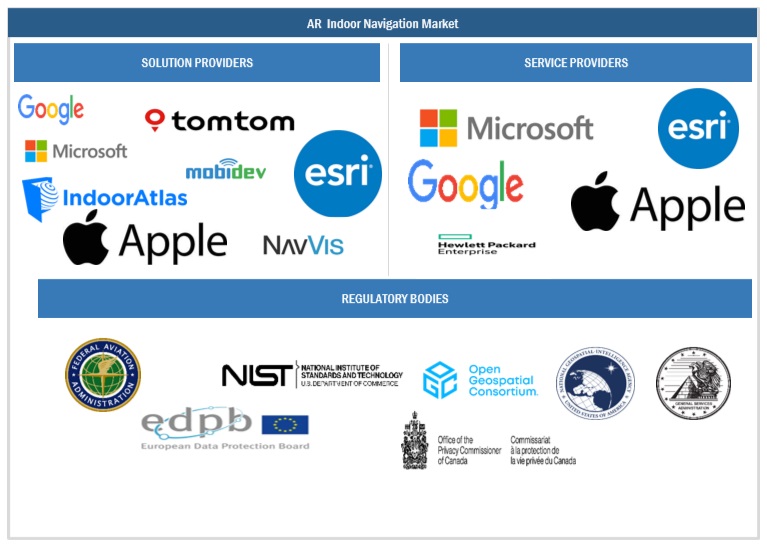AR Indoor Navigation Market - Global Forecast to 2030
The AR indoor navigation market is currently witnessing remarkable growth, with projections indicating a substantial increase in market size. Estimates suggest a notable expansion from its value of USD XX.X billion in 2024 to USD XX.X billion by 2030, reflecting a robust CAGR of XX.X% over the forecast period. AR indoor navigation provides a more interactive and engaging user experience than traditional navigation methods. It allows users to visualize and interact with their surroundings in real time, improving navigation accuracy and efficiency. Various industries, such as retail, healthcare, manufacturing, and logistics, are adopting AR indoor navigation to improve operational efficiency, enhance customer experience, and streamline processes.

To know about the assumptions considered for the study, Request for Free Sample Report
Market Dynamics
Driver: Advancements in AR Technology
AR (Augmented Reality) technology has been significant, driving the evolution of AR indoor navigation and its applications across various industries. These advancements reshape how AR is integrated into everyday experiences, making it more accessible, practical, and powerful. Where AR devices such as smart glasses, headsets, and mobile devices have seen improvements in display quality, processing power, and form factor, these advancements have made AR more immersive and comfortable for users, enabling them to interact with digital content seamlessly overlaid onto the physical environment.
Restraint: The adoption of AR indoor navigation is the inherent complexity of indoor environments.
Navigating accurately in complex indoor spaces using AR technology requires advanced mapping, tracking, and localization capabilities. The technology must map and recognize the indoor environment in real-time, understand the user's position and orientation, and provide accurate navigation instructions despite the complexities of the surroundings. The complexity of indoor environments can also pose challenges for maintaining the accuracy and reliability of AR indoor navigation systems. Changes in the environment, such as moving objects or temporary structures, can impact the effectiveness of navigation instructions if not accounted for in real time.
Opportunity: The integration of AR indoor navigation with IoT and smart building technologies
Integrating AR indoor navigation with IoT devices and sensors can provide users with enhanced navigation capabilities and interactive experiences. By leveraging data from IoT sensors, such as beacons or environmental sensors, AR navigation systems can offer real-time information about the surrounding environment, including factors like temperature, humidity, and occupancy, to enhance the user experience. Additionally, integrating AR indoor navigation with IoT devices can enable interactive features such as augmented reality overlays that display contextual information about points of interest within the indoor environment. For example, users could point their devices at a specific location in a museum, and AR overlays could provide detailed information about the exhibit or artwork they are viewing. In retail, AR overlays could display product information, pricing, or promotions when users point their devices at items on shelves.
Challenge: Data Integration and Management
Integrating data from various IoT sensors and devices into AR indoor navigation systems requires robust data integration and management processes. This involves collecting data from IoT devices, such as beacons or environmental sensors, and integrating it with the AR navigation system's data infrastructure. IoT devices often use different data formats and communication protocols, making standardizing and integrating data streams challenging. Data from diverse sources must be harmonized and processed to ensure compatibility and consistency within the AR navigation system.
AR Indoor Navigation Market Ecosystem

By offering, the AR indoor navigation hardware segment to account for a significant market size during forecast period.
AR indoor navigation hardware is expected to claim the largest market share in 2024. AR indoor navigation encompasses the physical devices and components required to enable augmented reality-based navigation and positioning within indoor environments. These devices serve as the primary interface for AR indoor navigation applications. They provide the display for AR overlays, processing power for running AR software, and connectivity for accessing location data and content.
By vertical, hospitals and healthcare facilities are slated to witness the highest growth rate during the forecast period.
The hospitals and healthcare facilities segment is experiencing notable growth in the AR indoor navigation market. Augmented reality (AR) transforms how we navigate indoor spaces, and hospitals and healthcare facilities are no exception. AR indoor navigation offers a variety of benefits for both patients and staff, making it a promising technology for the future of healthcare. AR can be beneficial for patients with disabilities or limited mobility. It can guide them to accessible entrances, elevators, and restrooms, making the hospital experience more inclusive. AR can overlay additional information on top of the real world, such as points of interest, wait times, and even educational content about their condition. This can make the hospital experience more engaging and informative for patients.
By region, Asia Pacific is set to experience a rapid growth rate during the forecast period.
Asia Pacific is swiftly establishing itself as the fastest-growing hub in the AR indoor navigation market, with several key factors driving its expansion. The Asia Pacific region is home to over half of the world's population, which is expected to grow in the coming years. This growing population creates a strong demand for efficient indoor navigation solutions in the healthcare, retail, and transportation sectors. Countries like China, Japan, and South Korea are investing heavily in technology, driving the development and usage of AR solutions. These countries are also home to some of the world's leading technology companies actively developing and deploying AR indoor navigation solutions.
Key Market Players
The AR indoor navigation solution and service providers have implemented various organic and inorganic growth strategies, such as new product launches, product upgrades, partnerships, agreements, business expansions, and mergers and acquisitions, to strengthen their offerings in the market. Some major players in the AR indoor navigation market include Apple (US), Google (US), IndoorAtlas (Finland), Pointr (UK), MazeMap (Norway), NavVis (Germany), Maze Engineers (US), Blippar (UK), TomTom (Netherlands), Esri (US), Situm (Spain), MobiDev (US).
Recent Developments:
- In December 2023, TomTom, a leading location technology specialist and AI map it, announced a global partnership. This collaboration centers on delivering image repository and AI services to clients worldwide, marking an exciting venture for both organizations.
- In October 2023, Google Maps enhanced the feature for immersive views for routes and other AI features. These Maps updates make it easier to plan and navigate with new search and exploration methods.
- In January 2023, Apple Maps gained a new tool, Apple Business Connect; it will now allow business owners to update and manage their information on the platform, including key details like business hours and location, photos, logos, special offers, promotions, and more.
- In July 2023, ExpoFP and indoor positioning platform IndoorAtlas announced a joint development: interactive floor plans with accurate indoor positioning and wayfinding.
- In July 2022, Esri launched the indoor positioning system ArcGIS IPS, which improves operational efficiency and safety. ArcGIS IPS enables real-time indoor location services through Esri’s ArcGIS Indoors mobile application and in custom apps built with ArcGIS Runtime SDKs.
- In October 2023, TomTom announced a new partnership with Flow Labs. This AI-powered transportation data platform offers high traffic data accuracy to enhance transport safety, equity, mobility, and environmental sustainability.
To speak to our analyst for a discussion on the above findings, click Speak to Analyst
















Growth opportunities and latent adjacency in AR Indoor Navigation Market